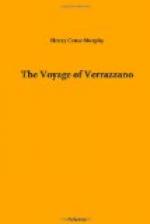Two sketches of the coast by Alfonse accompany this description, which are here reproduced united in one. The map in Ramusio (III, fol. 424-5), prepared by Gastaldi, shows the Terra de Nurumbega, of the same extent as here described, that is, from Cape Breton westerly to a river running north from the Atlantic and connecting with the St. Lawrence or river of Hochelaga. Gastaldi, or Gastaldo, published previously an edition of Ptolemy’s Geography (12mo., Venice, 1543), in which (map 56), Norumbega is similarly laid down, without the river running to the St. Lawrence. Norumbega was therefore a well defined district of country at that time.
The word was undoubtedly derived from the Indians, and is still in use by those of the Penobscot, to denote certain portions of that river. The missionary Vetromile, in his History of the Abnakis (New York, 1866), observes (pp. 48-9): “Nolumbega means A still-water between falls, of which there are several in that river. At different times, travelling in a canoe along the Penobscot, I have heard the Indians calling those localities Nolumbega.”
That the country did not become known through Verrazzano is evident from the letter, in which it is stated that he ran along the entire coast, from the harbor to which they remained fifteen days, one hundred and fifty leagues easterly, that is from Cape Cod to the Island of Cape Breton, without landing, and consequently without having any correspondence with the natives, so as to have acquired the name.
When in particular Alfonse ran along the Atlantic coast is not mentioned, though it is to be inferred that it was on the occasion of Roberval’s expedition. There is nothing stated, it is true, to preclude the possibility of its having taken place on some other voyage previously. It could not have been afterwards, as the cosmography describing it was written in 1544-5. Some authors assert that Roberval dispatched him towards Labrador with a view of finding a passage to the East Indies, without mentioning his exploration along Nova Scotia and New England. But Le Clerc, who seems to have been the author of this statement (Premier Etablissement de la Foy dans la Nouvelle France, I, 12-13. Paris, 1691), and who is followed by Charlevoix, also alleges that on the occasion of his exploration towards Labrador, he discovered the straits between it and Newfoundland, in latitude 52, now known as the straits of Belle Isle, which is not correct. Jacques Cartier sailed through that passage in his first voyage to Canada, in 1534. Le Clerc either drew false inferences or relied upon false information. He probably derived his impression of the voyage to Labrador and the discovery of the straits by Alfonse, from a cursory reading of the cosmography of Alfonse, who describes these straits, but not as a discovery of his own.




